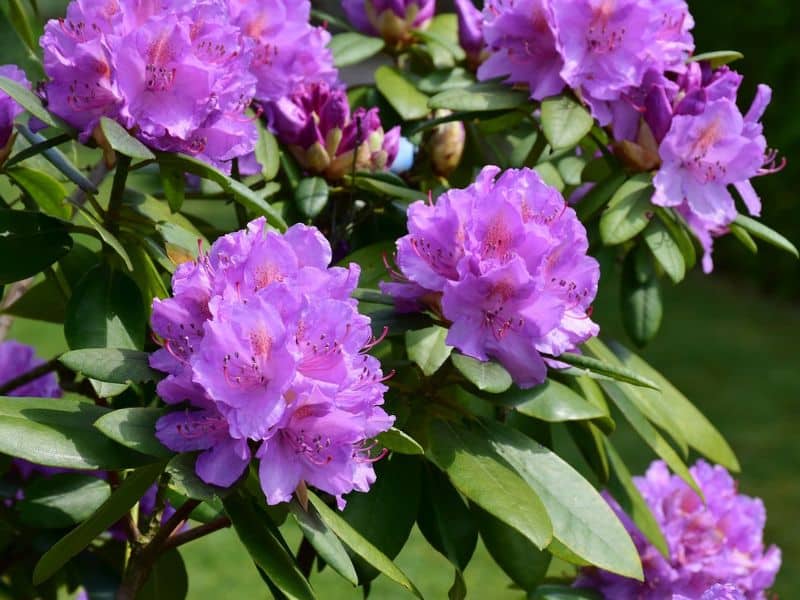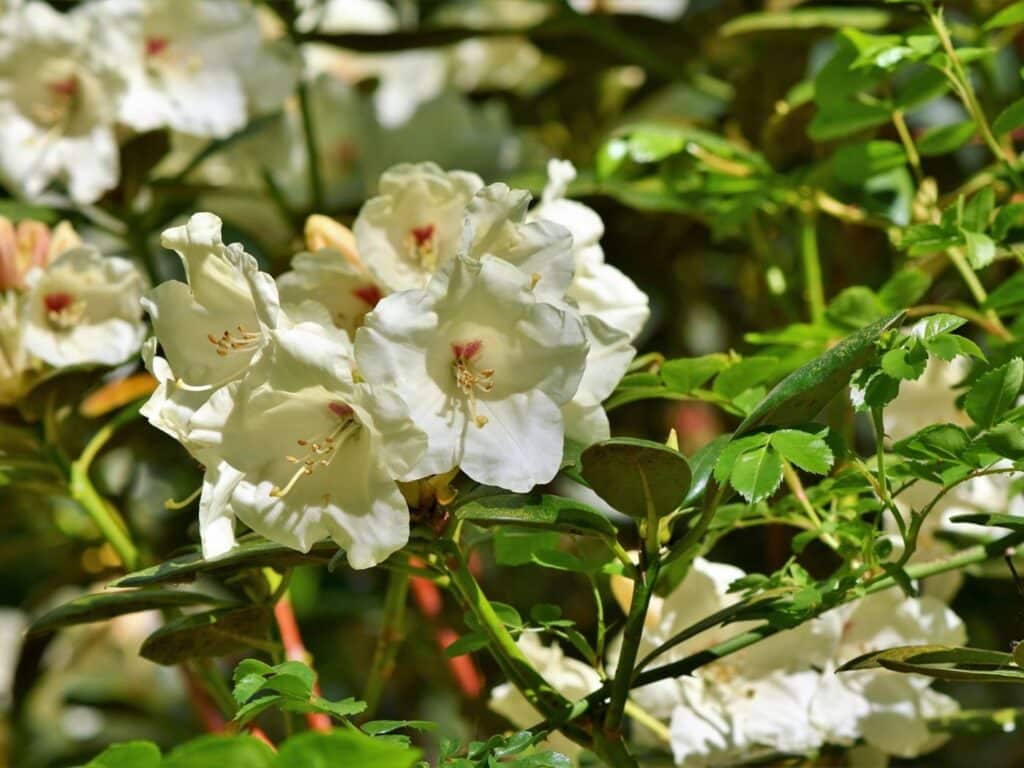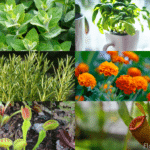Are your rhododendron leaves turning yellow, and you’re left wondering why? You’re not alone. This common issue plagues many garden enthusiasts, leaving them puzzled and frustrated.
This article aims to shed light on this perplexing problem. It’s not just about identifying the issue, but also finding effective solutions. So, let’s delve into the world of rhododendrons and understand what makes them tick, and more importantly, what’s causing them to turn yellow.
Get ready to turn your yellowing rhododendrons around and restore them to their vibrant, healthy selves. Your garden’s pride and joy needn’t be a cause for concern anymore.
Understanding Rhododendron Leaf Yellowing
Master the reasons behind the yellowing of rhododendron leaves and learn about their life cycle. This knowledge allows you to take the right steps towards maintaining a healthy rhododendron garden.
Causes of Yellow Leaves
Rhododendron leaves can turn yellow due to several factors. One prime cause lies in nutrient deficiencies. Rhododendrons thrive in acidic soil, thus, if the soil lacks appropriate acidity, stress manifests through their leaves turning yellow. Iron or magnesium deficiencies also result in yellow leaves.
Another important factor is water issues. Both overwatering and underwatering create stress for rhododendrons, leading to leaf yellowing. Overwatering restricts oxygen supply to roots, causing them to decay, whereas underwatering leads to dehydration, both turning leaves yellow.
Pests and diseases can also cause leaf yellowing. In particular, root rot and leaf spot diseases are two common culprits. A sudden change in environment, such as weather or location, can also lead to stresses resulting in yellow leaves.
The Life Cycle of Rhododendron Leaves
Beyond onset issues, rhododendron leaf yellowing can be part of their natural life cycle. Rhododendrons are evergreen plants, carrying their leaves for 1-3 years before they naturally turn yellow and drop.
Younger leaves appear bright green while older ones manifest a darker shade. Eventually, older leaves begin to yellow, signaling the end of their life span. Understanding this cycle helps in recognizing whether your rhododendron leaves turning yellow is a problem or merely a part of their natural aging process.
Armed with this information, you’ll be better equipped to manage and care for your rhododendrons, ensuring that they remain a vibrant and healthy part of your garden.
Nutrient Deficiencies and Soil Problems

Identifying the root causes behind your Rhododendron leaves turning yellow requires an understanding of the plant’s nutritional needs and the role that soil plays in meeting these needs. This section delves into nutrient deficiencies and soil-related issues that may lead to the yellowing of rhododendron leaves.
Identifying Nutrient Deficiencies
Plants thrive when they receive balanced nutrition. In rhododendrons, specific nutrient deficiencies often manifest as yellow leaves. For example, a lack of nitrogen often causes older leaves to turn yellow.
Iron deficiency, marked by yellowing between leaf veins, is another common issue in rhododendrons. If you spot these signs, consider conducting a soil test to identify deficiencies accurately and rectify them with appropriate fertilizers.
Impact of Soil pH on Rhododendron Health
Rhododendrons prefer slightly acidic soil with a pH ranging from 4.5 to 6.0. Soil pH outside this range can lock essential nutrients, making them unavailable to the plant, leading to yellow leaves. Incorporating organic matter like compost or peat moss into your soil can enhance its acidity and improve nutrient availability. Regular soil testing ensures optimal pH levels for your rhododendrons, aiding in their vibrant and healthy growth.
Watering Issues Leading to Yellow Leaves
Being mindful of watering practices can spare rhododendrons from turning yellow. Delve into the reasons and the ramifications of poor watering practices.
Overwatering and Its Consequences
Overwatering hampers rhododendrons’ root function, making it difficult for the plant to absorb nutrients. Excessive water in the soil rid the roots of oxygen, leading to root rot. You may well notice the leaves first changing to a lighter shade of green before turning yellow and wilting.
With prolonged overwatering, the leaves could gradually brown and drop off, leaving a bare plant. Preventing overwatering involves using well-draining soil, using pots with drain holes, and watering only when the top inch of soil becomes dry.
Underwatering Stress on Rhododendrons
Conversely, underwatering rhododendrons put them under extraordinary duress. Rhododendrons’ shallow roots have difficulty accessing moisture from deeper in the soil. Underwatered rhododendrons display droopy and dull leaves that ultimately turn yellow.
The plant’s growth also stalls, and it can exhibit browning at the leaf edges. By maintaining regular watering during dry periods, and ensuring the soil remains moist, you can evade the stress that leads to yellowing leaves.
Disease and Pest Infestations
Continuing the narrative from the pinnacle of watering issues, let’s delve into an equally important thread—diseases and pests. A healthy rhododendron isn’t invincible—it can fall prey to certain diseases and pests that lead to the yellowing of leaves.
Common Diseases Affecting Rhododendrons
Your rhododendron’s discolored leaves may well indicate the presence of diseases. The most prevalent diseases include root rot and leaf spot. Root rot, instigated by Phytophthora, a damaging fungus, results in wilting, yellowing leaves and the eventual death of the plant if left unchecked.
By contrast, leaf spot diseases, caused by various kinds of fungi, don’t always result in yellowing, but they do lead to spots that reduce the overall aesthetics of your rhododendron.
Another commonly encountered enemy in rhododendrons is dieback. Botryosphaeria dothidea, the fungus responsible, invades branches, leading to wilting and yellowing of leaves. Implement immediate countermeasures, or risk losing the plant, as the disease spreads rapidly and shows no mercy.
Pests That Lead to Yellowing Leaves
Pests, detracting from your rhododendron’s vibrant luster, can lead to the yellowing of leaves. Predominantly, rhododendrons suffer from the attacks of vine weevils and lace bugs.
Vine weevils, a double-threat, attack both above and below soil. Their larvae target root systems causing wilting and yellowing of leaves, while adults feast on leaves at night, causing unsightly notches.
Conversely, lace bugs are known culprits behind the stippling and yellowing of rhododendron leaves. They feed on the undersides of leaves, causing them to turn not just yellow, but also greyish-white in severe infestations. In both cases, the key to recovery is prompt intervention.
Environmental Factors and Seasonal Changes
Rhododendrons, just like any other plant species, are victims of weather and seasonal cycles. These seemingly uncontrollable aspects can become integral parts in the overall health and vibrancy of your beloved rhododendrons, making their understanding indispensable.
Weather-Related Stress on Rhododendrons
Ever noticed how the bright, happy demeanor of your rhododendrons seems to shift with bad weather? That’s no coincidence, plants are more in tune with Mother Nature than you may well think. For example, extreme conditions such as prolonged drought, hail storms, or sudden frost can place remarkable stress on rhododendrons.
This stress manifests visibly through leaf yellowing, curling, or wilting. A drastic drop in temperature can also cause leaf discoloration as the plant attempts to ‘harden’ itself for the chilly times ahead. Sudden environmental changes can induce similar signs of stress, which can lead to yellowing leaves.
In the face of severe weather conditions, it’s imperative that you provide the necessary protection to your rhododendrons. This may well include moving the plant to a warmer area during frost, or providing a shade cover during extreme heat.
Understanding Seasonal Leaf Changes
As the seasons change, you may well notice your rhododendron’s leaves turning yellow, particularly in autumn. This is normal behavior for the plant, as older leaves make way for new leaves to grow in the spring.
More more precisely, rhododendrons see a significant part of their leaves, usually the oldest ones, turn yellow and eventually fall off as a part of their natural life cycle. This large-scale ‘fall’ usually happens in the spring, but it can also happen in the fall, adding to the natural yellows and oranges of the season.
Being familiar with your plant’s natural behavior helps you determine whether the yellowing leaves are simply part of its seasonal routine or an indication of an underlying problem. Familiarize yourself with the nuances of your particular rhododendron variety, as different types can have different seasonal behaviours.
In a nutshell, a keen eye, a patient demeanor, and a protective instinct can go a long way in ensuring your rhododendron flourishes despite a hostile weather environment or changing seasons.
Management and Prevention Strategies
Proper Watering Techniques
Optimal watering promotes the health of your rhododendrons. Over-watering or under-watering often triggers a shift in leaf color. The general guideline involves keeping the soil consistently moist but not waterlogged.
Drainage forms an essential aspect of watering; thus aim for well-draining soil. Consider soil dryness at a depth of one to two inches before deciding to water your emanates.
For example, water your rhododendrons once or twice a week in dry periods, adjusting based on rainfall conditions. But remember, your plants require less water in winters when growth slows.
Adjusting Soil Conditions for Healthy Growth
Achieving the right soil conditions dictates the growth and vitality of rhododendrons. pH plays a paramount role in regulating nutrient uptake. These plants thrive in acidic soil, with a pH range between 4.5 to 5.5.
Test your soil annually, making the necessary amendments if pH levels diverge from this bracket. Integrating organic matter like compost or peat moss can help acidify the soil, contributing to its overall fertility.
Preventative Care and Regular Maintenance
Building a preventive routine gives rhododendrons a significant advantage. Regularly inspect the foliage and stems for signs of pests or diseases, as these often cause yellowing leaves.
On recognising an issue, take immediate action that may involve treating with insecticidal soap for pests or applying appropriate fungicides for disease control.
Prune dead branches in early spring, which will promote healthy new growth. Additionally, applying a balanced slow-release fertilizer ensures the plants obtain all necessary nutrients. Use a 10-10-10 (Nitrogen-Phosphorous-Potassium) formula, applying it in early spring before new growth sprouts.
FAQs
Why are my rhododendron leaves turning yellow?
Yellowing of the rhododendron leaves could be due to nutrient deficiencies, water issues, pests, diseases, or environmental changes. Addressing these issues with proper care and maintenance can restore your plant’s health.
What role does balanced nutrition play in maintaining rhododendron health?
Balanced nutrition is vital for rhododendrons. It ensures they receive the needed nutrients and avoid deficiencies that can lead to conditions such as yellow leaves.
How can improper watering affect my rhododendron?
Over or under watering your rhododendron can lead to yellow leaves due to root damage. Maintaining proper watering techniques helps ensure optimal rhododendron health.
What is the importance of soil pH for rhododendrons?
Rhododendrons prefer an acid soil with a pH of 4.5 – 6.0. If the pH is not within this range, they could suffer from nutrient deficiencies leading to yellow leaves.
How can I prevent pests and diseases from damaging my rhododendron?
Implementing preventative care, like regular maintenance and inspections, can help you address pest and disease issues early before they severely affect your rhododendron.
How can environmental changes impact rhododendrons?
Sudden environmental changes like temperature drops or changes in lighting can stress rhododendrons, which may result in yellow leaves. Keeping the plant in a consistent environment can help avoid this issue.
Up next:







